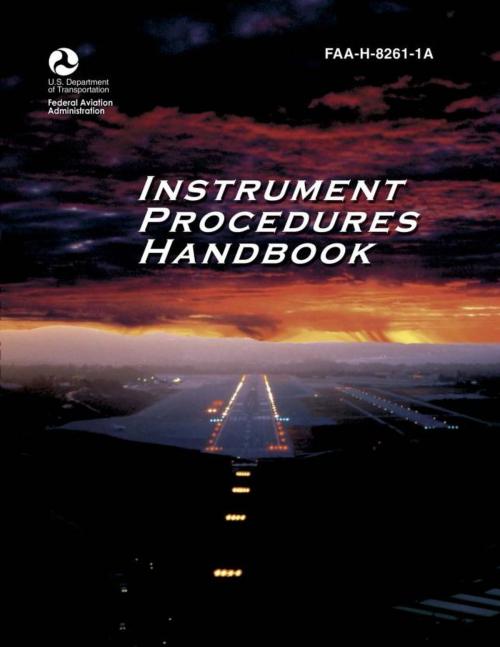| Author: | Federal Aviation Administration | ISBN: | 1230002052762 |
| Publisher: | Federal Aviation Administration | Publication: | December 18, 2017 |
| Imprint: | Language: | English |
| Author: | Federal Aviation Administration |
| ISBN: | 1230002052762 |
| Publisher: | Federal Aviation Administration |
| Publication: | December 18, 2017 |
| Imprint: | |
| Language: | English |
This is the new 2015 edition of the FAA's previous "Instrument Procedures Handbook" (previously the FAA-H-8083-16).
In the FAA's "Instrument Procedures Handbook" (#FAA-H-8083-16A) the emphasis is placed on operations and procedural information for real-world use, which makes this the next logical step for pilots after learning basic instrument skills from the FAA's "Instrument Flying Handbook" (#FAA-H-8083-15B). Using this book, pilots can more directly apply the concepts to their current flying situation, and learn how their acquired skills are best used in today’s IFR environment. With the increased occurrence of regulatory changes, pilots must be aware of current procedures. This book covers all of the information needed to operate safely within the airspace system.
Updates for the new edition were made to reflect new information as well as current practices and procedures related to Terminal Arrival Areas, RNAV and GPS-based approaches, ILS and parallel ILS approaches, and important concepts and principles related to obstacle avoidance and departure planning, among others. These updates and the reorganization of material should be reviewed by anyone who flies in or will be flying in instrument meteorological conditions (IMC).
Considered industry-wide as a top source for instrument procedures information and a “must read” for all instrument pilots, this new 2015 Edition brings pilots the latest changes to procedures and even more insights and guidance on how to operate safely within the national airspace system. Detailed information is provided for every navigation receiver and phase of flight on the required precision necessary to stay within protected airspace and to make a successful approach.
The Instrument Procedures Handbook was intended primarily as a technical reference for professional pilots. However, with the specialized glossary, index, full-color illustrations and photographs, flight instructors, instrument pilots and instrument students alike will find it a valuable training aid. Each topic covered is well-detailed and explained in user-friendly terms, along with full-color depictions to aid understanding.
Instrument flight instructors, pilots and students will need this resource since it is used as a reference for the Airline Transport Pilot and Instrument Knowledge Tests and for the Practical Test Standards. Detailed coverage of instrument charts and procedures including IFR takeoff, departure, en route, arrival, approach, and landing, safety information such as runway incursion, land and hold short operations, controlled flight into terrain, and human factors issues also are included. Whether a pilot is a seasoned professional or recently completed an Instrument Rating course, this FAA handbook is sure to encourage more precise instrument techniques and ultimately create a safer pilot.
This is the new 2015 edition of the FAA's previous "Instrument Procedures Handbook" (previously the FAA-H-8083-16).
In the FAA's "Instrument Procedures Handbook" (#FAA-H-8083-16A) the emphasis is placed on operations and procedural information for real-world use, which makes this the next logical step for pilots after learning basic instrument skills from the FAA's "Instrument Flying Handbook" (#FAA-H-8083-15B). Using this book, pilots can more directly apply the concepts to their current flying situation, and learn how their acquired skills are best used in today’s IFR environment. With the increased occurrence of regulatory changes, pilots must be aware of current procedures. This book covers all of the information needed to operate safely within the airspace system.
Updates for the new edition were made to reflect new information as well as current practices and procedures related to Terminal Arrival Areas, RNAV and GPS-based approaches, ILS and parallel ILS approaches, and important concepts and principles related to obstacle avoidance and departure planning, among others. These updates and the reorganization of material should be reviewed by anyone who flies in or will be flying in instrument meteorological conditions (IMC).
Considered industry-wide as a top source for instrument procedures information and a “must read” for all instrument pilots, this new 2015 Edition brings pilots the latest changes to procedures and even more insights and guidance on how to operate safely within the national airspace system. Detailed information is provided for every navigation receiver and phase of flight on the required precision necessary to stay within protected airspace and to make a successful approach.
The Instrument Procedures Handbook was intended primarily as a technical reference for professional pilots. However, with the specialized glossary, index, full-color illustrations and photographs, flight instructors, instrument pilots and instrument students alike will find it a valuable training aid. Each topic covered is well-detailed and explained in user-friendly terms, along with full-color depictions to aid understanding.
Instrument flight instructors, pilots and students will need this resource since it is used as a reference for the Airline Transport Pilot and Instrument Knowledge Tests and for the Practical Test Standards. Detailed coverage of instrument charts and procedures including IFR takeoff, departure, en route, arrival, approach, and landing, safety information such as runway incursion, land and hold short operations, controlled flight into terrain, and human factors issues also are included. Whether a pilot is a seasoned professional or recently completed an Instrument Rating course, this FAA handbook is sure to encourage more precise instrument techniques and ultimately create a safer pilot.















